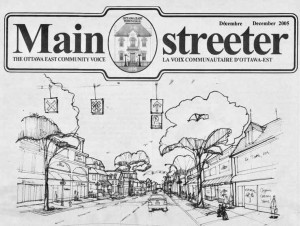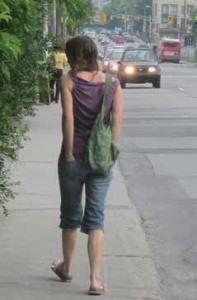John Dance
“Picture a village – with a bakery, fresh vegetable or fruit store and maybe a cafe or a coffee shop set back on wide, treelined sidewalks spilling with people and decorated with vintage lamp posts, flower pots and benches.”
That’s how journalist and Mainstreeter contributor E. Kaye Fulton summarized the collective desire of Old Ottawa East residents of 15 years ago. Fulton was one of over 500 people who responded to The Mainstreeter’s eight-question Main Street Revitalization Survey back in 2005, and their perspectives are fascinating to consider a decade and a half later.
They “want the commercial heart along Main Street and Hawthorne Avenue to be rescued, resurrected and renewed,” Fulton wrote. The “unanimous” view was that the community wanted a greater variety and number of shops and services. That Main Street was widely regarded as an “arterial speedway” was a key barrier to the desired transformation.

The front page of The Mainstreeter of December 2005 had an architect’s image of how Main Street might ideally look. Image by Lasley and Associates, Landscape Architect
Residents also sought such things as more footpaths, and “pedestrian friendly options such as bike lanes, a weekend farmers’ market and pedestrian links to sister communities in the Glebe and along Elgin Street.”
The strong consensus was that there should be a mix of commercial and residential on Main Street – “only two percent wanted Main to be wholly residential.” Top choices for new businesses were a coffee shop, bakery, vegetable store, post office, library, pub and butcher.
The impetus for The Mainstreeter survey was City Council’s refusal to respect the community’s request that the development of the townhouses at the corner of Evelyn Avenue and Main street, which at the time was the site of the Peach Garden Restaurant, have “a viable commercial element on any frontage along Main.” Capital Ward Councillor Clive Doucet fought Council’s decision but, as he told the community association at the time, “From the perspective of many City officials, the community of Old Ottawa East does not exist.”
The revitalization survey and related community-led meetings gave rise to the development community design plan, which was approved in 2011 and contained many of the elements sought in the 2005 survey, and also helped launch the rebuilding of Main Street as a complete street.
Main Street’s buried infrastructure was crumbling and the time had come to replace it. The City realized that the configuration of the street and sidewalks could also be considered since they all needed to be replaced anyway. After many meetings of the Main Street Renewal Working Group, with its many representatives for residents, businesses, churches, schools and other organizations, Ottawa’s first “complete street” design of a core route was submitted to the City’s transportation committee. After four hours of debate, the redesign scraped through, but then was widely supported at City Council. Construction began in 2015 and the “new” Main Street opened from the Queensway bridge to the McIlraith (Smyth) Bridge two years later.
Meanwhile, developers had bought all of the Oblates’ and half of the Sisters’ property bordering on Main Street, leading to specific proposals that, for the most part, adhered to the vision and constraints of the community design plan and the “secondary plan” that gave it legitimacy.

Narrow and sloping sidewalks with overhanging branches were the norm in OOE, along with speeding vehicles on the commute to work. Photo by John Dance
So how has Old Ottawa East changed relative to what was sought in the survey? To a surprising extent, OOE of today fulfills many of the dreams and desires of the residents of 15 years ago. Notably, as some drivers complain, Main Street in 2020 is anything but a “speedway.” However, it is safer and more comfortable for cyclists and pedestrians, despite some cyclists who insist on riding the wrong way or not respecting pedestrians.
The children’s garden and the greatly improved Saint Paul University grounds have made Main Street a much more pleasant and interesting street. The completion of the Flora Footbridge and the new pathways along the river and beside the LRT route now provide the pedestrian and cycling connectivity that was sought.
“I recall the neighbourhood initiative to try to slow cars down on Main Street on weekends by parking (legally) on Main Street on Saturday mornings,” says Mary Trudeau, one of the founding members of Sustainable Living Ottawa East. “I did it a few times but it was really taking your life in your hands as cars easily went 60km/hour down the street as a norm. Today, 15 years later, I no longer avoid walking on Main Street and the traffic speeding problem has been addressed without putting our cars in the direct line of fire. I would never have considered biking along Main Street but I do so now regularly.”
Jan D’Arcy, who was both editor of The Mainstreeter and president of the community association in 2005, says “We got exactly what we were after. Our community really came together.” She notes how we have the weekend farmers’ market, a number of new cafes and restaurants and, now, Nu Grocery. And she says, “We got Main Street done in an even better way than we envisioned.”
“We’re very happy with the changes and how things are gradually shaping up on Main Street as the trees fill out and more retail stores move in,” comment Dorothy and Ron Shigeishi of Onslow Crescent. “We’re pleased with the Nu Grocery but are still wishing for a Cedars-like general grocery, a pub and especially a new community centre in the Deschâtelets building.”
Similarly, Burnham Road resident Margaret Moriarity comments, “I am happy with the changes to Main Street. The dedicated bike paths and wider sidewalks are what please me the most.” But Moriarity laments, “It would have been nice if the former Petro-Canada station site [north corner of Main Street and Springhurst Avenue] had become a small park.”
The loss of green space is a concern of others as well. “I still miss the green open lands that used to be so prominent in the neighbourhood,” says Trudeau. “I don’t think there was as much attention paid to ensuring habitat was protected and created along the shoreline as there should have been but there may still be projects in the works to introduce and rehabilitate lost habitat for snapping turtles, frogs, birds and the occasional snake along the river.”
And despite the new vibrancy of Main Street at Domicile’s Corners on Main and the enduring Green Door restaurant area, all three commercial units in the apartment building at the corner of Main Street and Lees Avenue are vacant.
“We need an Old Ottawa East BIA,” says D’Arcy, calling for the creation of a business improvement area such as the one Glebe businesses support.
“At the moment, Old Ottawa East is enjoying a renaissance,” says former Councillor Doucet. “It won’t be the same as it once was. It won’t be as wild or quiet but the essentials of a sustainable community are growing, not declining. By sustainable, I mean a community where more people walk, people know their neighbours, live, play and don’t go too far away to work.”
According to Doucet “…it was a great joy representing these communities at City Hall and very satisfying because we won many battles that helped preserve the essential community qualities in Old Ottawa East, the most important being access to the river and a Main Street used as a community street as well as a place to move cars along, and of course the footbridge.”
So, overall, it seems that sustainable progress has been made in revitalizing the community. Given the many goals that Old Ottawa East residents have achieved so far, now may be the time for The Mainstreeter to seek our readers’ views on what Old Ottawa East should be like in another 15 years.







